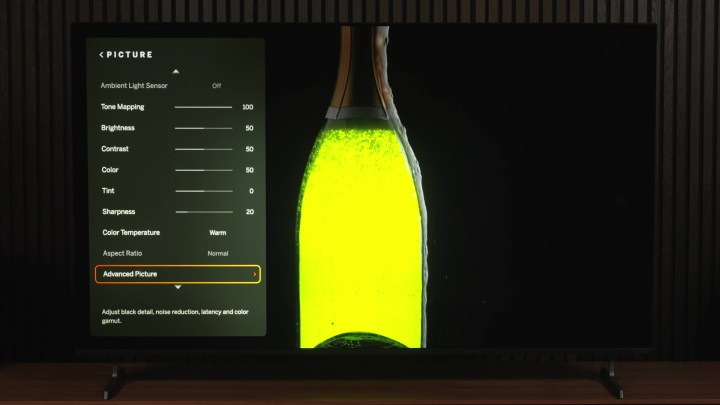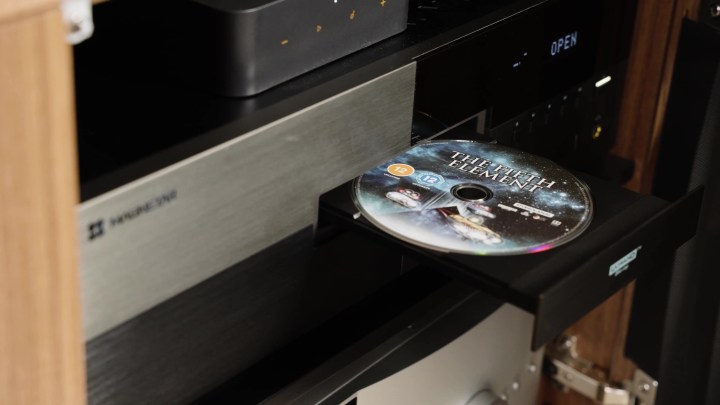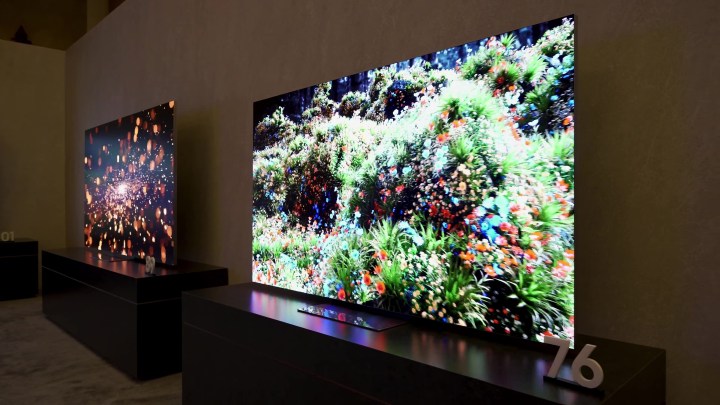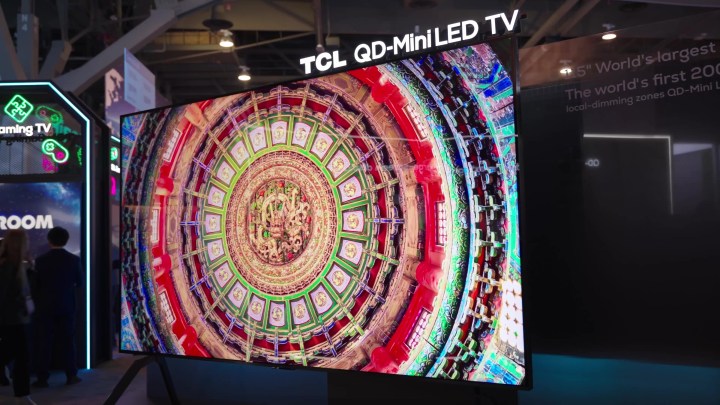On this episode of You Asked: How do brightness and tone mapping affect SDR content? (Or do they?) Aren’t all Blu-ray players basically the same? What’s the difference between mini-LED and microLED? And when is TCL’s monstrous 115-inch, 5,000 NIT TV going to come out?
Tone mapping

James Barrett writes: Is tone mapping turned on by default? Or do we have to manually adjust this to create optimum brightness according to the ambient lighting in the same room as the LG TV?
And Christian Brind’Amour writes (regarding the TV brightness episode of You Asked and tone mapping): Very informative, thanks. How does this apply to regular or cable TV? It seems you were only bringing up HDR-type content.
For those who haven’t seen it, I did a video and accompanying article about TV brightness, the nit wars, and why it seems like TV makers are just going crazy trying to one-up each other with how bright they can get.
There were a few things I wish I had included in that video, like the fact that double the nits does not equal double the brightness. And there were some more technical aspects that Christian’s question brings up.
Tone mapping — which, in short, is the process by which a TV executes brightness according to the instructions it is given — is a process related to handling HDR content. So for regular TV and cable, most of which is in SDR, then tone mapping doesn’t apply. The TV will never get instructions for brightness that exceeds something like 200 nits.
With SDR, you can turn the brightness of your TV up and down as you see fit and make the bright parts of the image as bright or as dim as you like. You don’t get that option with HDR because the brightness — or backlight setting — is maxed out. You don’t have the option to adjust the average picture level — or average brightness — which is why some folks complain about HDR content being too dim. Tone mapping is just part of HDR, though there is static tone mapping, which means the TV does more or less what it is supposed to, or Dynamic tone mapping, which means the TV does whatever the TV maker wants it to do.
I was talking to another YouTuber – Classy Tech Calibrations — about this recently. HDR is mastered to be watched in a dark room, meaning that some HDR content will appear too dim if you watch it in a sun-soaked room.
Now, I have to contradict something I said earlier. You can make HDR content brighter with a cheat on some TVs. Sometimes, Active Tone Mapping or Dynamic HDR will just give you a brighter overall image. On some TVs, you can select the brighter version of the HDR picture preset to make the picture brighter. Or, in the case of Dolby Vision IQ, you can use a TV’s built-in light sensor to adjust the tone curve so that the brightness of the picture is optimized to look good depending on the brightness of your room.
And in another surprising and somewhat odd move, it appears Vizio is building in a tone mapping slider on its TVs, which lets you adjust the overall brightness of HDR content up or down. That’s an interesting move.
Bad Blu-ray

Ymi Yugu writes: Why are there good and bad Blu-ray players? I thought it was just a digital signal sent digitally to the TV.
It is about time we get to a question like this. I will try to answer it as simply as I can because we could get deep here. Too deep.
I get where this question comes from. I, too, once thought that part of what makes a digital format or a digital signal so great is that it is just ones and zeroes, and it either gets from one place to another or it doesn’t, and there’s no in-between. If that were the case, there’d be no need for “premium” HDMI cables. no need for premium digital audio players, and no need for premium Blu-ray players. The digital video and digital audio revolution was somehow this great equalizer, right? It’s as simple and straightforward as black or white, yes or no, one or zero — no gray area. Just goodness.
Unfortunately, we got the wrong idea. I think I started learning this lesson when I began to learn a little about how DACs — or digital-to-analog converters — work. I learned there was such a thing as a clock in a CD player; it’s the part of a CD player that syncs up with a DAC and tells it exactly when to decode a signal. It essentially controls the rhythm of a CD player.
And not all of them are created equal.
But we’re talking about Blu-ray players here. And while the Blu-ray format reduced some of the variance in picture quality we saw among DVD players before them, it didn’t eliminate variance.
Ideally, every decoder, processor, and upscaler built into a Blu-ray player would be the same quality. They wouldn’t do anything to the signal, leaving the display device as the only variable — your television, usually. But we know that is not the case. There is variance among Blu-ray players and, thus, variance in the signal they output. Not a ton, but it does exist. Subjectively, I can tell you the image from a Magnetar Blu-ray player looks better than the Sony PlayStation 5 Blu-ray player but is virtually indistinguishable from the Sony Blu-ray player I have on the bench. I lack the instruments to quantify those differences, but several people were here when I did the A/B comparison, and they saw it, too, without my prompting. In a blind test, the Magnetar beat the PS5 every time.
But the difference in video quality is probably the least important factor. The most important difference to me is build quality. Super cheap Blu-ray players have transports and motors that aren’t built to last. They will likely die over time. Also, cheap Blu-ray players have cheap DACs that don’t sound as good as premium players. So if you’re using it for audio playback and using analog outputs, that’s another reason to buy a more premium player. Then there’s the user interface, boot-up time, load times, and a bunch of other touch points that may make one Blu-ray player more desirable than another.
But, yeah, the whole “digital is digital, and it is all the same thing” doesn’t hold water no matter what some blow-hard in a forum tells you. Without any dog in the fight, I’ve witnessed the differences myself time and again over the 28 or so years I’ve been at this.
Mini-LED vs. microLED

Power5 writes: Is mini-LED the same as Samsung microLED? These small-size tech names are getting confusing.
Mini-LED and microLED are different in terms of size and, thus, how they are used.
A mini-LED bridges the gap between a conventional LED and a microLED. Conventional LEDs — you’re probably familiar with what those look like — are always over 200 micrometers in size.
Mini-LEDs span 100 to 200 micrometers in size. A microLED must be under 100 micrometers.
The size difference is key because it determines how they can be used in displays. A mini-LED is useful as a backlight for an LCD-based television. As we’ve discussed here before, since they are so much smaller than conventional LEDs, more of them can be packed into a space and broken down into more tightly controlled zones. That’s the promise, anyway. Depending on their use, sometimes mini-LED TVs are better for having them, but sometimes they aren’t much better than TVs with normal-sized LEDs.
Mini-LEDs, though, are not tiny enough to be grouped together to represent a single pixel in a conventional-sized television. However, microLEDs are. Or at least, they can be.
A pixel on a TV needs to be able to produce red, green, and blue. And microLEDs are so tiny that a red, green, and blue microLED can be shoved in the space of one pixel. It took a while to scale them down to be tiny enough to be in a 65-inch display – but they have been, and Samsung showed us that at CES recently.
TCL X955

Ian writes: It has been quite a while since you covered the new TCL X955 TV. You mentioned it again in your CES 2024 coverage, but there was little new technical or sales information. I am yet to see any shipping information for this TV. I was wondering if you have any insights into what is happening with the availability of this TV. I am in Australia, so we are always late to the party. I have been waiting for reviews and availability as I am considering the 85-inch X955 for my home.
I am concerned that this new TV doesn’t appear to have been shipped to any reviewers. Testing, reviews, or insights into the TV are not yet available. Given some of your observations and comments about the new Hisense TVs at CES, could TCL be tweaking the X955 specifications before release?
Great question. First off, don’t be concerned. It is very common for TV brands to announce TVs several (or many) months in advance of their availability. I imagine they enjoy building anticipation and demand as folks like us chew on the knowledge that it will exist, but have to wait until we can finally buy them.
I can’t tell you exactly when the TVs from TCL will be available, but I can offer some well-educated guesses.
First, for anyone who may not have been following: TCL Global made an announcement in late August 2023 that the X955 TV — a 5,000-nit TV — would be coming. Very exciting. Then, more recently, at CES in January 2024, TCL North America announced the QM89 – a 115-inch, 5,000-nit TV.
The X955 announced globally and the QM89 announced for North America are not exactly the same. But they are very close.
For North America, I can tell you that we will likely not hear more about the QM89 or any of TCL’s other TVs until sometime in May. In May 2023, I attended the TCL event in New York, where that year’s lineup was shown and announced. I got my first impressions of the QM8 in all its glorious sizes. Then, TCL’s TVs started hitting store shelves in mid-June.
I assume the same will happen in 2024: new TCL TVs, at least in North America, coming in June, with a sneak peek in May. I do not know the release window for Oceania, but I reckon it won’t be too far off that timeline.
Historically, big and ambitious TVs like the 115-inch QM89 have come out a bit later than the core TV lineup — we’ve seen this from several brands. It is possible that could happen here. But I have a very strong, clairvoyant vibe going here that the QM89 could also be available in June. We may not have to wait until later in the year for it.
Wouldn’t that be awesome?
Anyway, if you want to see the first meaningful preview and impressions of the QM89 — guess where you’ll see it? Yup. Right here.
Editors' Recommendations
- You asked: Should you buy a 70-inch TV, do you really need a Blu-ray player, and more?
- Why TCL’s 5,000-nit X955 is a brightness bomb of QD-mini-LED





